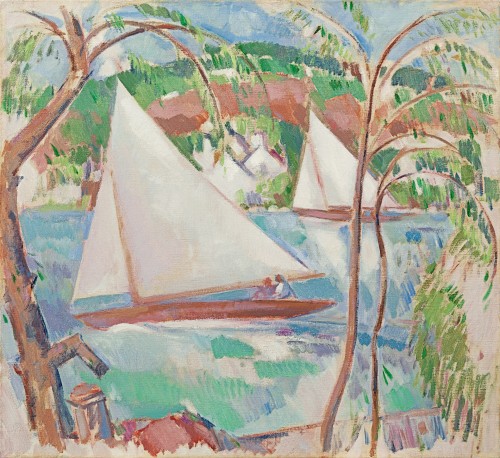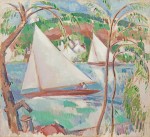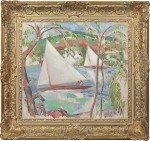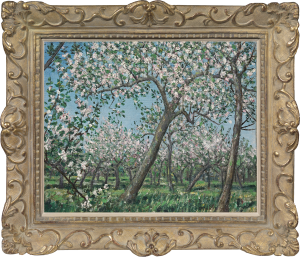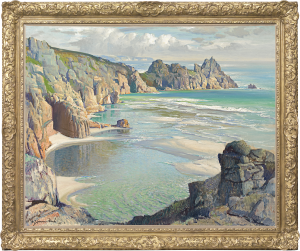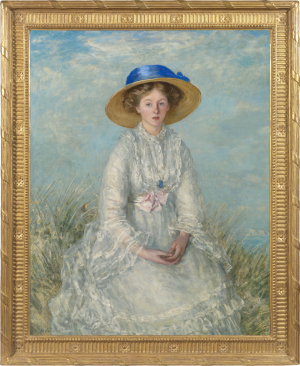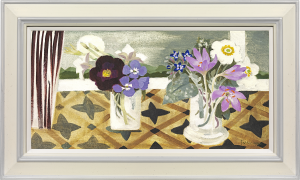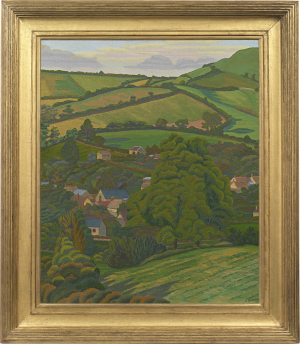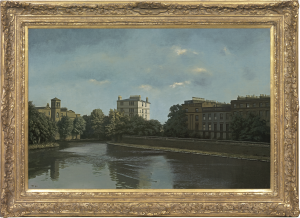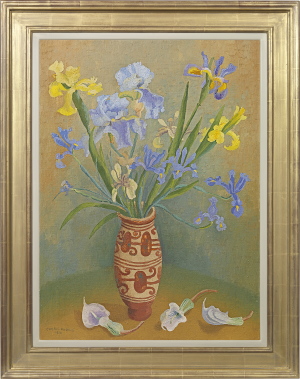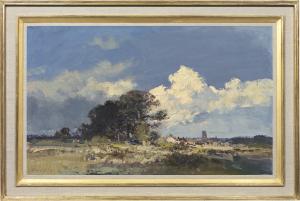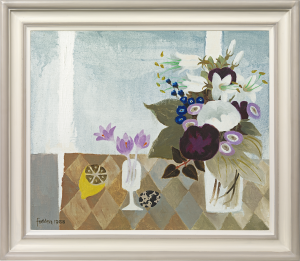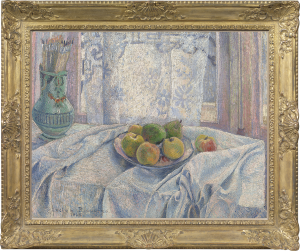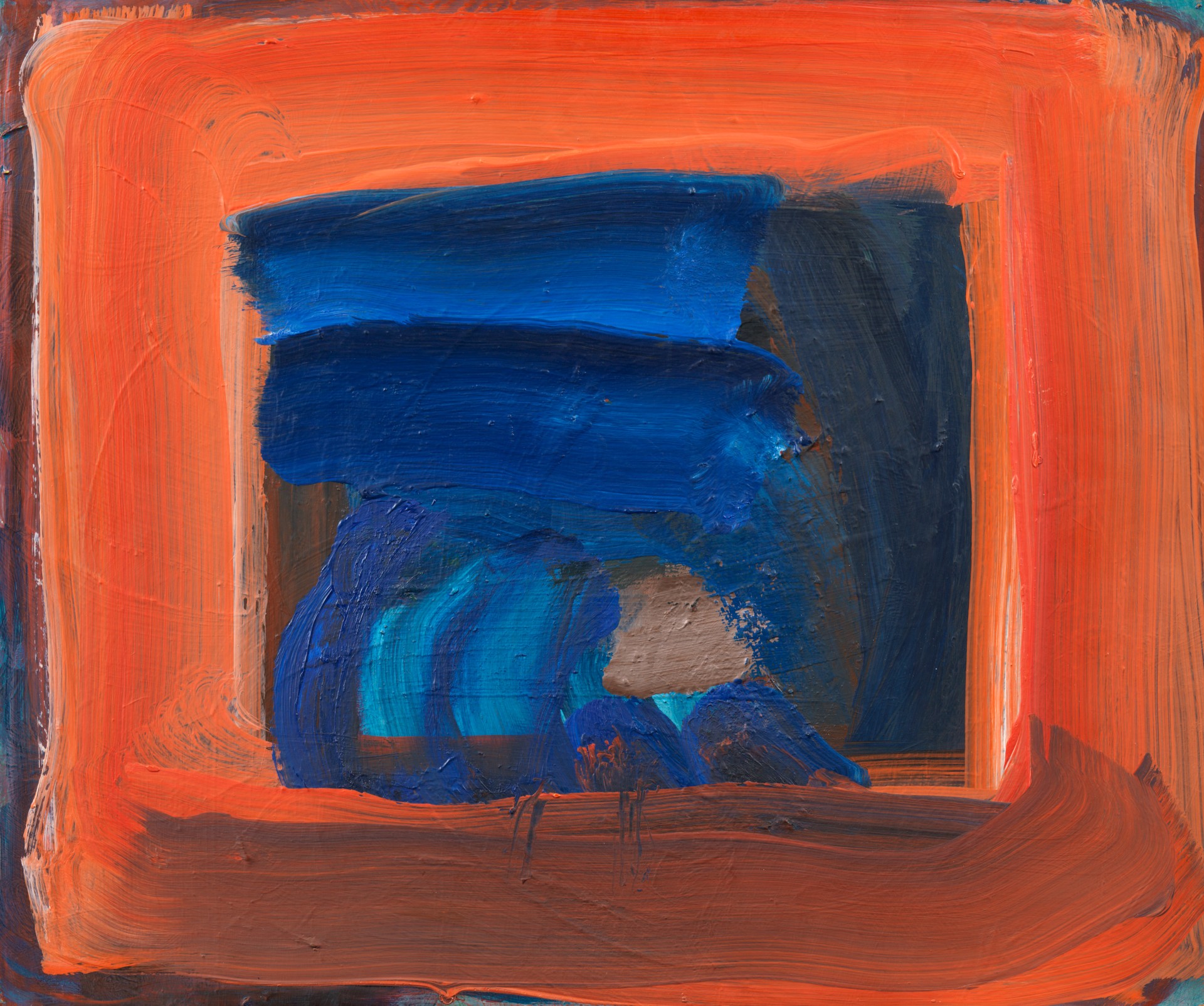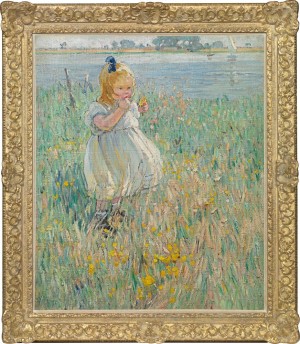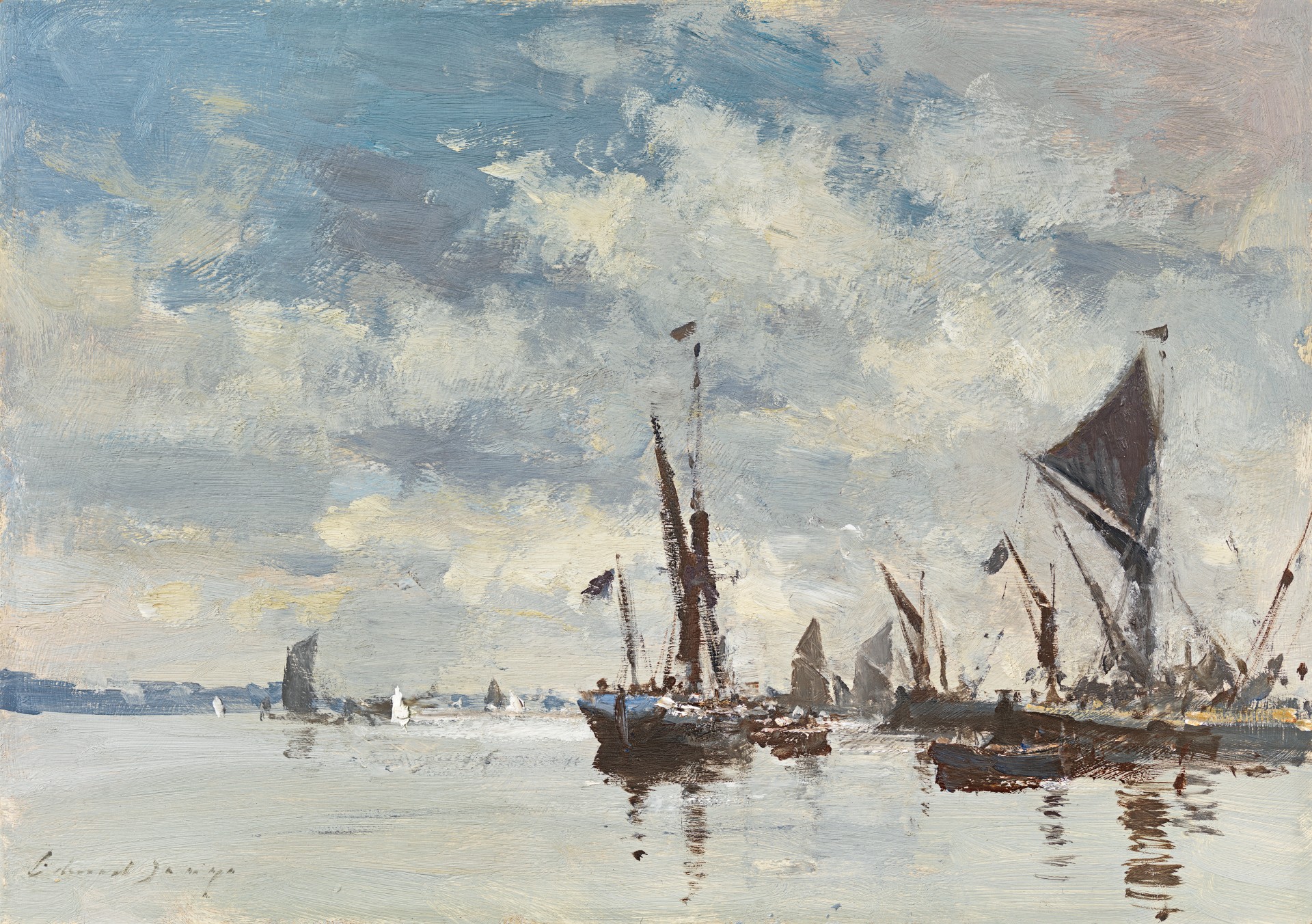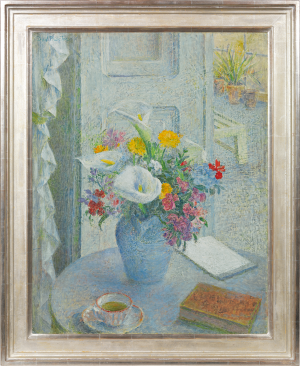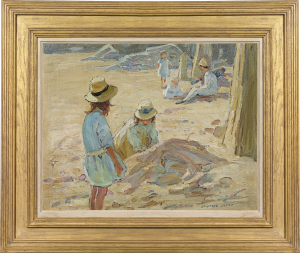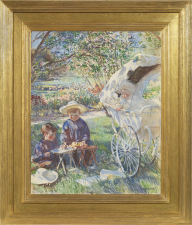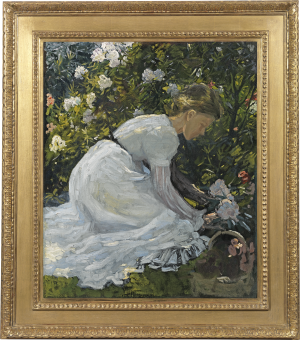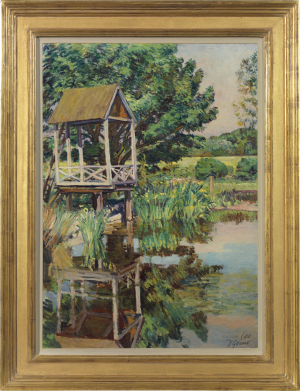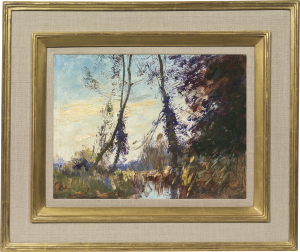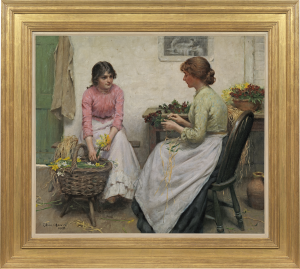John Duncan Fergusson
Yachts, Bourne End
Oil on canvas: 22 x 24.3 (in) / 55.9 x 61.6 (cm)
Signed and dated on the reverse: J. D. FERGUSSON. / - 1927
This artwork is for sale.
Please contact us on: +44 (0)20 7493 3939.
Email us
JOHN DUNCAN FERGUSSON
Leith 1874 - 1961 Glasgow
Ref: CB 179
Yachts, Bourne End
Signed and dated on the reverse: J. D. FERGUSSON. / - 1927
Oil on canvas: 22 x 24 ¼ in / 55.9 x 61.6 cm
Provenance:
Alexander Reid & Lefevre, London
Private collection
Sotheby’s Edinburgh, 23rd March 1993, lot 278;
Mary Mabel Tannahill (1932-2022) and her husband David Jones, acquired from the above
Exhibited:
London, Lefevre Gallery, Painting & Sculpture by JD Fergusson, February 1928, no.9
Literature:
W Egerton Powell, ‘What we are coming to (some recent art exhibitions), Artwork, vol.4, Spring 1928, no.13, p.7, illus.
John Duncan Fergusson’s Yachts, Bourne End is a post-impressionist masterpiece of light, colour and dynamic form. The luminous, triangular sails of two sleek yachts dominate the nearly square canvas, their bright reflections fractured across the beautiful blue green water. The warm red brown of their masts and hulls is echoed in the picturesque, natural landscape which surrounds them. In contrast to the geometric sails, the framing foreground trees stretch up to the top of the canvas in undulating curves, their arching branches and fresh green leaves further energising the scene.
This important painting was included in Fergusson’s solo exhibition at the Lefevre Gallery, London in 1928 and was written about by W Egerton Powell in his review for the journal Artwork: ‘Of the re-actionary movement which came later and is generally known as “Post-Impressionism,” there are good grounds for believing that the most virile exponent in Great Britain is John Duncan Fergusson…Mr Fergusson, even before 1914, was accepted there [in Paris] as a chef d’école and painter of importance. Since it is very many years since he had a one-man-show in London, and since he very rarely exhibits anywhere in London, the Fergusson Exhibition at the Lefevre Galleries this February has been an event of importance. It demonstrates effectively that though Fergusson probably knows far more about the latest Parisian theories of painting than any stalwart of Bloomsbury, he is the most personal and least derivative of any British post-impressionist. Fergusson’s gifts are many. He is a fine virile draughtsman, as befits a fellow-countryman of Raeburn. He is a really intoxicating colourist, his schemes being radiantly gay and bright, joyous without being cloying. And he is an immensely learned and skilful designer in three dimensions. For sheer decorative beauty the claims of such pictures as “Yachts, Bourne End,” “The Valley, Cassis,” or “At the Bathing Place” are undeniable.’[1]
This painting was exhibited as Yachts, Bourne End, which suggests the location is near Marlow in Buckinghamshire, and may even depict the Bourne End Week Regatta in June at Upper Thames Sailing Club, also known as ‘Cowes on Thames.’ British Pathé footage of the event the year before captures the elegance of the boats on the river in the Race for the Queen’s Cup: http://ww.britishpathe.com/asset/52142
Twilight, Royan, 1910 On the beach at Tangier, 1899 Bathers and Yachts, 1931
Oil on board: 27 x 34.9 cm oil on canvas: 75.9 x 75.9 cm Oil on canvas: 92.5 x 73.5 cm
National Galleries of Scotland : Kelvingrove Art Gallery & The Fegusson Gallery, Perth
Modern Museum
The Breeze, Antibes, 1913-14 Blue Submarine: Portsmouth Golfe-Juan, 1937
Oil on canvas: 54 x 65 cm Harbour, 1918, Oil on canvas: Oil on canvas: 54.6 x 65.4 cm
Government Art Collection 61 x 56 cm The Fergusson Glasgow Museums
Gallery, Perth
JOHN DUNCAN FERGUSSON RBA
Leith 1874 - 1961 Glasgow
John Duncan Fergusson was the fourth and most independent member of the group of Scottish Colourists. Intellectually more receptive to the artistic ideas he encountered in Paris, he evolved a distinctive style of his own. Having embarked on a medical career, Fergusson never matriculated and gave up in order to devote himself to art. He first visited Paris in the mid-1890s and attended classes at the Académie Colorossi. During this period he was impressed by the works of Richard Parkes Bonington (1802-1828) in the Louvre and the Impressionists in the Salle Caillebotte in the Musée du Luxembourg. He visited Morocco in 1899 and Spain in 1901, the year in which he became a member of the Royal Society of British Artists.
Fergusson held his first one-man exhibition at the Baillie Gallery, London in 1905 and settled in Paris two years later, where he befriended the Anglo-American circle of artists. He was greatly influenced by Henri Matisse (1869-1954) and the Fauves which resulted in the brightening of his palette and a new boldness of line. From 1910 onwards, a new theme dominated his work, that of the female nude in pictures characterised by their rich colouring and rhythmic, geometric patterning. One of these works, entitled Rhythm, gave rise to a literary magazine of the same title, of which he became editor in 1911. He met Margaret Morris, his future wife in 1913, and visited Cassis with Peploe the same year.
At the outbreak of the First World War, Fergusson returned to London; he was appointed a War Artist with the Royal Navy in 1918 and painted a series of Portsmouth Docks. He held two exhibitions in New York in 1926 and 1928 and returned to Paris in 1929, where he remained until the outbreak of the Second World War. Fergusson moved back to Glasgow in 1940 where he founded the New Art Club, out of which emerged the New Scottish Group in 1942. His first retrospective exhibition was held at the McLellan Galleries in 1948, and he was made an honorary LL.D. of the University of Glasgow in 1950.
The work of John Duncan Fergusson is represented in Aberdeen Art Gallery & Museums; the University of Aberdeen; Rozelle House Galleries, South Ayrshire; Dundee Art Galleries and Museums; the Scottish National Gallery of Modern Art, the Scottish National Portrait Gallery, Edinburgh, City of Edinburgh Council; Kirkcaldy Galleries, Fife; the Hunterian Art Gallery, University of Glasgow, Kelvingrove Art Gallery and Museum, Glasgow; Glasgow Museums Resource Centre; Ferens Art Gallery, Hull; McLean Museum and Art Gallery, Inverclyde; Tate Britain, Imperial War Museums, Arts Council Collection, Government Art Collection, Royal Academy of Music and the Fleming Collection, London; Manchester City Galleries; Paisley Museum and Art Galleries, Renfrewshire; Perth & Kinross Council; Rugby Art Gallery and Museum; the National Trust for Scotland; the University of Stirling; Southampton City Art Gallery; Atkinson Art Gallery, Southport and Ulster Museum, National Museums Northern Ireland.
[1] W Egerton Powell, ‘What we are coming to (some recent art exhibitions), Artwork, vol.4, Spring 1928, no.13, pp.5-6.

